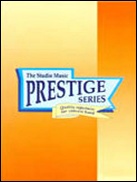Results
-
 £107.95
£107.95SWISS FESTIVAL OVERTURE, A (Prestige Concert Band Set) - Sparke, Philip
Score and Parts. This light overture was written for a contest for both wind and brass bands held in Langenthal and funded by the Berne Music Association. It opens slowly and majestically and, after a climax, includes a section in free time for the trumpets and a cadenza for the euphonium. A lively, toe-tapping allegro follows with a central legato melody and a final flourish that recalls the opening fanfares. Performance time 9'37" (Recorded on QPRM115D GREAT BRITISH MUSIC FOR WIND BAND, Western Band of the Royal Air Force)
Estimated dispatch 7-14 working days
-
 £3.95
£3.95TIME TRAVEL (Part 4 in B flat BC) - Strachan, Keith
Trombone, Euphonium (for Continental Europe)
Estimated dispatch 7-14 working days
-
 £3.95
£3.95TIME TRAVEL (Part 4 in B flat TC) - Strachan, Keith
Tenor Saxophone, Baritone, Trombone, Euphonium
Estimated dispatch 7-14 working days
-
 £3.95
£3.95TIME TRAVEL (Part 4 in C BC) - Strachan, Keith
1st Bassoon, 1st Trombone, Euphonium
Estimated dispatch 7-14 working days
-
 £3.95
£3.95TIME TRAVEL (Part 5 in B flat TC) - Strachan, Keith
Bass Clarinet, Euphonium, B flat Bass
Estimated dispatch 7-14 working days
-
 £137.99
£137.99TUBBY THE TUBA (Tuba/Concert Band) - Kleinsinger, George - Duncan, Andrew
Score & Parts. Duration: 8:00 American Grade 3. Set Includes: 2 Full Score (one for Narrator); Solo Tuba C BC; Piccolo; Flutes 1 & 2; Oboe' Clarinet in Eb' Clarinets 1&2 in Bb' Bass Clarinet in Bb' Alto Saxophones 1 & 2 in Eb' Tenor Saxophones 1&2 in Bb; Bassoons 1 & 2; Horns 1 & 4 in F; Horns 2 & 4 in F; Trumpets 1 & 2 in Bb; Trombones BC 1 & 2; Euphoniums in Bb TC; Euphoniums BC; Tuba; Double Bass; Timpani; Percussion; Tuned Percussion. World Parts also included: Solo Tuba in Eb TC; solo Tuba in Eb BC; Horns 1 & 3 in Eb' Horns 2 & 4 in Eb' Trombones 1 & 2 in Bb TC; Trombones 1 & 2 in Bb BC; Bass Trombone in Bb TC; Bass Trombone in Bb BC; Euphonium in Bb BC; Tuba in Eb TC' Tuba in Eb BC' Tuba in Bb TC' Tuba in Bb BC.
Estimated dispatch 7-14 working days
-
£94.99
Vocalise (Concert Band - Score and Parts)
Vocalise is the second movement from Satoshi Yagisawa's Trombone Concerto. Yagisawa finally decided to publish this movement as a separate piece, since it has been frequently performed independently and on the euphonium, tenor saxophone or the trombone. Just like the title implies, Vocalise exhibits a warm, gentle chorale-like feel that any audience will enjoy. Also available in an edition with piano accompaniment. 0:03:50
Estimated dispatch 7-14 working days
-
 £49.95
£49.95WINTER DAYS (Flexible Solo/Easy Concert Band) - Mortimer, John Glenesk - Sedlak, Jan
A lyrical piece. Solo part provided for: Flute; Clarinet; Bassoon; Alto & Tenor Sax; Trumpet; Horn; Trombone; Bass Trombone; Euphonium; Tuba; Violin; Viola; Cello; Contrabass. American Grade 2+ Duration: 2:34
Estimated dispatch 7-14 working days
-
 £105.10
£105.10YAKETY SAX (Flexible Solo with Intermediate Concert Band) - Schneiders, Hardy
Solo for Flute, Clarinet, Alto Sax, Tenor Sax, Trumpet, Trombone or Euphonium. Duration: 1:40
Estimated dispatch 7-14 working days
-
£3.95
ZOO BALL (Part 4 in B flat BC) - Strachan, Keith
Trombone, Euphonium (for Continental Europe)
Estimated dispatch 7-14 working days
